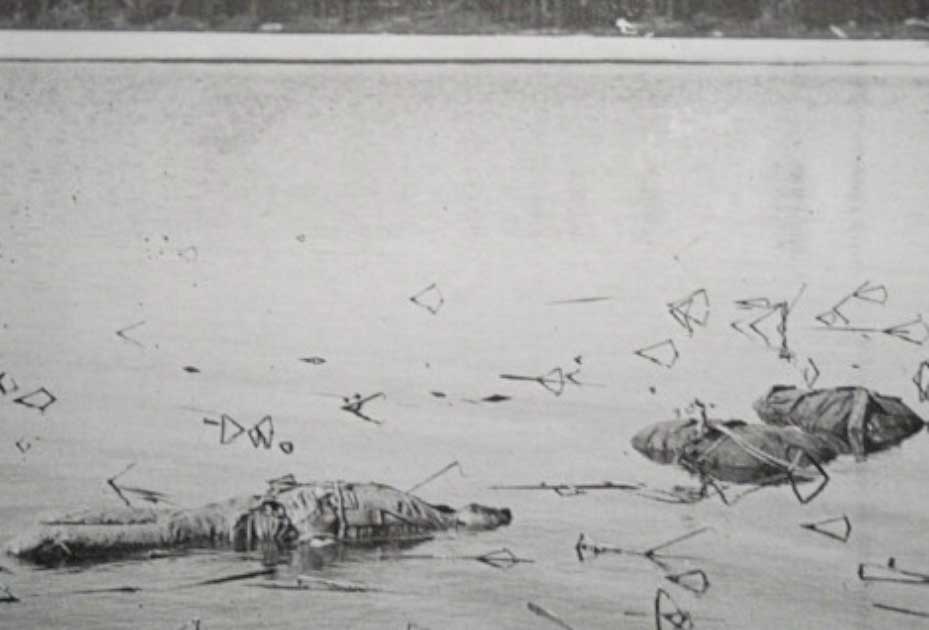One April morning in 1924, the weather in Deschutes National Forest in Oregon could only be described as perfect. The weather was glorious, bright blue skies, and the frost of winter was turning into a rich green. Little Lava Lake, a picturesque body of water in the heart of the forest, had thawed and boats could cruise around again.
That morning a group of outdoorsmen gathered at the banks of the lake. The men were searching the lake, but not to find a perfect spot to fish. They were there to haul the bodies of three murdered men from the lake. The Lava Lake Murders shook Deschutes County, and still haunt the community to this day.
What were the Lava Lake Murders?
The Lava Lake Murders was a triple murder of three men near Little Lava Lake, earlier that year. The men Dewey Morris (age 25), Edward Nickols (age 50), and Roy Wilson (age 35) were from Bend, Oregon, the principal town of the county. All three men had headed into the park the previous year, and had planned to spend the fall and winter near Lava Lake working as fur trappers.
The trappers had arranged to stay in a log cabin owned by a logging contractor from Bend, Edward Logan. Logan had agreed to let the men use his cabin near the forest as a base camp for their fur trapping.
In exchange for a place to stay that winter, the three men agreed to care for five valuable foxes Logan had been raising for fur on his property. The arrangement worked well for everyone involved, and the trappers moved into the cabin.
A few days before Christmas of 1923, Edward Nickols returned to Bend to sell his furs. He sold an entire sled’s worth of fur, and locals said that Edward looked happy and told them that the fur trapping was going incredibly well thus far.

The men were seen alive again, when on January 15, 1924, holiday camp owner Allen Wilcoxen was snowshoeing from his home in Fall River to the resort he owned at Elk Lake, 28.6 miles (46 km) away. Allen stopped and spent the night at the cabin before resuming the trek to his resort the following morning.
When later questioned by the police, Allen said the men were “in high spirits and good health.” Nothing strange occurred during his overnight stay in the men’s cabin. Allen told police that the men had spoken of another successful trapping expedition.
This was the last time the men were seen alive.
Missing Men
Innis Owen Morris, Dewey’s brother, began to worry when around two months had passed since he had last heard from his brother. The cabin was reasonably remote but there was no reason for this silence, and Morris was concerned.
Innis recruited the superintendent of the Tumalo Fish Hatchery, Pearl Lynnes, to check the cabin and find the men. At the cabin, the dining room table was set for a meal, and pots were found on the stove, filled with burned food. Whatever had happened, it had been sudden and unexpected.
Traps, food, winter clothing, and rifles were all found abandoned in the cabin, and there were no signs of a struggle. The sled the men used to transport goods and their equipment was however missing. Knowing that the trappers were allowed to stay at the cabin if they cared for Edward Logan’s foxes, the men immediately headed to the fox pen. All five valuable foxes were missing, and a claw hammer stained with blood was all that was found in the pen.
Alerted to the missing men, Deschutes County Sheriff Clarence Adams came to the cabin to investigate what could have happened to the three trappers. Adams was a former game warden and was familiar with the area where the cabin was located.
Under his supervision, the sled the trappers had been using was found half-buried in the snow and stained by something dark. The officers noticed nearby that a hole had been cut into the frozen lake and then refrozen.
A patch of snow with human blood, a front tooth, and clumps of hair were found. Nearby, lay the expertly-skinned bodies of 5 foxes. However, little could be done in the freezing temperatures and a search of the lake needed to be delayed until the thaw.
When the lake had thawed enough to be searched by boat, the three men’s bodies were located in the water.
The Investigation Begins
The official cause of death for all three of the men in the Lava Lake Murder case was gunshot wounds and blunt force trauma caused by a hammer. According to the autopsies, Ed Nickols was killed by a shotgun at close range, removing his bottom jaw and part of his chest.
Dewey Morris has been shot in his left elbow and a hole was found behind his right ear, likely caused by a hammer to his skull. The last trapper, Roy Wilson, had been shot in his right shoulder, almost removing it completely. He also had been shot execution-style with a bullet behind his left ear.
The medical examiner estimated that the men were murdered some time in January. This would have been after Allen Wilcoxen had stayed at the cabin; possibly the resort owner had just avoided what had happened.
Due to the remote location and the expertly skinned foxes, the police believed that the murderer was likely familiar with the area. After a tip off by a man named Edward Logan, the police turned their attention to Lee Collins, a trapper who had threatened to kill Nickols the previous year.
It was uncovered that Lee Collins was not the man’s real name, which was Charles Kimzey. Kimzey was a felon who had escaped the Idaho State Prison where he was sentenced to 15 years and was on the run. Kimzey was also a skilled outdoorsman, and considered “a person so despicable that no crime is beyond him, even a triple murder.”

Kimzey had been most recently charged for the attempted murder of a stagecoach driver who had been hired to drive Kimzey back to Idaho. Midway into the journey, Kimzey attacked the driver, tying his hands and feet up and throwing the man into a well.
The driver was able to work out his restraints, climbed up the wall, and went for help at a nearby home. He was also able to identify Kimzey as his attacker. Kimzey was charged, but fled town before he went to trial and disappeared.
It took the police a total of nine years to find Kimzey in Kalispell, Montana and bring him into custody. When questioned by police he gave an alibi that he was working in Colorado on building the Moffat Tunnel at the time of the murders: he claimed to have never heard of the three men or their deaths.
Kimzey was unable to prove his alibi, but with only circumstantial evidence linking him to the murders the authorities were unable to press charges. However, Kimzey was not a free man, and was sent to Oregon State Penitentiary, given a life sentence for his attempted murder of the stagecoach driver
Kimzey was never officially charged with the Lava Lake Murders, but he has been the suspected killer for almost a century. Crime author Melany Tupper claimed in her 2013 book, The Trapper Murders, that Kimzey had an accomplice.
Tupper believes that a man named Ray Jackson Van Buren was Kemzey’s partner in the murders. Van Buren had been linked to several unsolved murders across Oregon but no proof has been found to legitimize Tupper’s claim. Van Buren killed himself in 1938, five years after Kimzey was captured, leaving any proof of taking part in the Lava Lake Murders to the grave.
The case remains unsolved and is one of the oldest unsolved murder cases in the history of Oregon. What happened and who killed the three trappers in the cabin in 1924 will remain an unsolved case. The real murderer could have been hiding in the woods unseen, or blended in among the residents of Bend, Oregon.
Top Image: Murder below zero: who murdered the three and dumped their bodies in Lava Lake? Source: Rechitan Sorin / Adobe Stock.
By Lauren Dillon